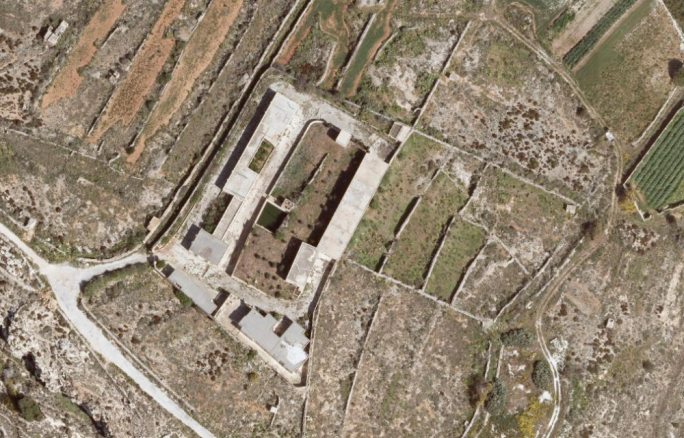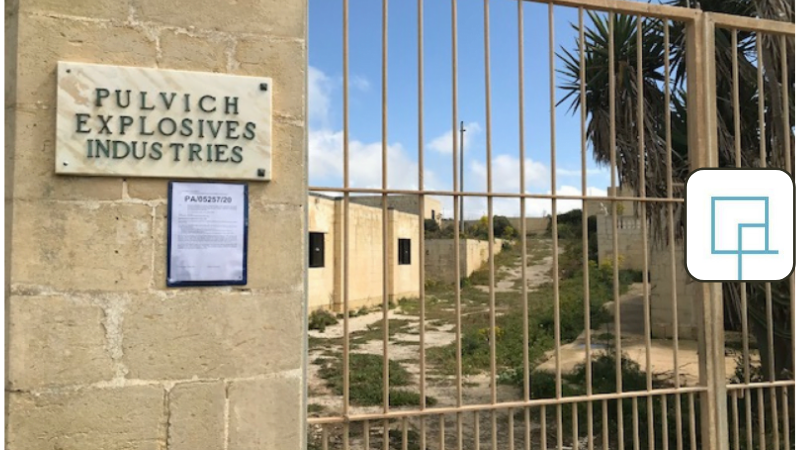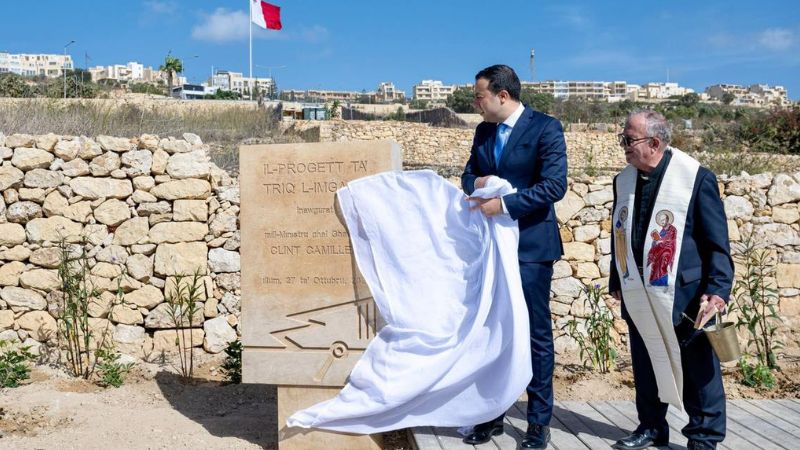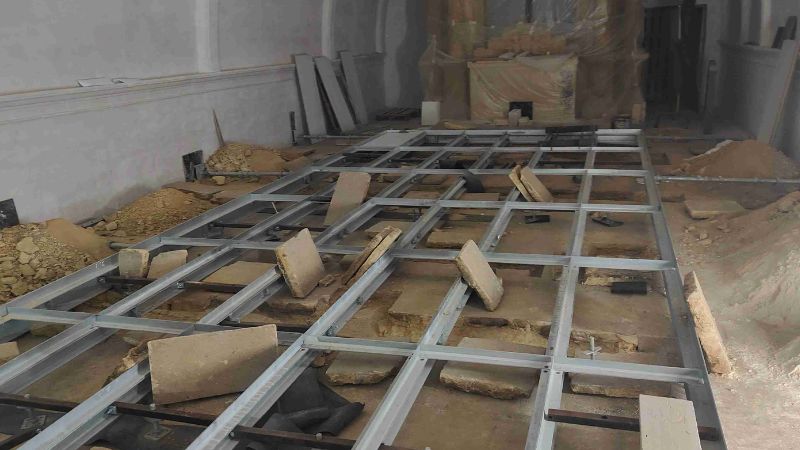The controversial application aiming to convert an abandoned explosives factory into a hotel has been recommended for approval by the Planning Authority, according to the case officer’s assessment published on Tuesday.
According to the Planning Directorate, the proposal to build a hotel spread out in a Natura 2000 site that is supposedly protected by different layers of environmental constraints will lead to “an improvement to the existing and dilapidated building, both in terms of visual impact and design, and its environmental aspect”.
The site currently hosts an abandoned explosives factory that had been granted a permit in 1987 due to the dangerous nature of the work carried out on-site, with any other applications filed by the Pugliesevic family that owns the site being denied since then.
The current application (PA/05257/20), filed on behalf of Sunroute Hotels Ltd, also known as the owners of JB Stores, are seeking to convert the 6275sqm factory site into 10, one-floor blocks with a total built-up footprint of 1,599sqm, along with an additional 269sqm to be dedicated to 20 parking spaces.

The location of the abandoned explosives factory.
It is not known what kind of deal the applicants may have struck with the landowners (Pugliesevic) in order to be able to file the application. The architects behind the application are JG Periti.
The Pugliesevic family made various efforts over the last 20 years to use the land for commercial development. The family acquired the land for close to nothing for use as an explosives factory in a remote area, due to the dangerous nature of the activity. They were given a permit by the government just before the 1987 election, on the condition that the land is used exclusively for that purpose.
The Planning Authority’s case officer argued that the development does not exceed the current footprint, that it improves the aesthetics of the current buildings, and that measures such as “earth colour tones” and the additions of shrubs through landscape would mitigate visual impact, making the project satisfactory enough for approval.
The development would accommodate 14 guest bedrooms within those 10 blocks and features a communal pool area, landscaping works and the reinstatement of rubble walls that feature on the site.
The site, besides being under the protection of Natura 2000, is also considered to be an Area of High Landscape Value and Ecological Importance, along with being designated as a Special Area of Conservation of International Importance due to its coastal position overlooking Mtaħleb and Dingli cliffs.
At least 500 objections have been filed, many of which were deploring the environmental impact of the project and the effects such development would have on the flora and fauna in the area in particular. Many objectors, including Dingli’s local council and several eNGOs, also added that the factory should be demolished and the area reinstated.
The objectors also pointed out that the approval of this project would set “a dangerous precedent” for such a highly-protected site, laying down a pathway for other projects in similar areas.
In spite of all the layers of environmental protection supposedly afforded, the Environment and Resources Authority (ERA) had green-lit the project after it was downsized from previous applications, imposing limitations on the height and breadth of the buildings but generally approving of the development.
ERA had also concluded that the project does not require an Environment Impact Assessment, a usually crucial component in determining what effects such a development would have on its surrounding ecological environment.
The authority also dismissed the notion that the development would have “any significant impacts on the integrity of the species, habitats, and the Natura 2000 site as a whole” as long as the conditions it laid down for the development were adhered to.
Conversely, the Superintendence for Cultural Heritage and the Cultural Heritage Advisory Committee “strongly” objected to the development, arguing that it would “inevitably result in the formalisation of this significant cultural and rural landscape in an Outside Development Zone”.
The Agricultural Advisory Committee stated that the site, although already significantly developed as is, is ultimately not being re-used for agricultural purposes, making the application incompatible with Rural Policy and Design Guidance rules which outline how sites in such settings should be used for purposes related to the rural environment.
The Shift has previously reported on how in the weeks leading up to the filing of the application, Infrastructure Malta had spent €350,000 on expensive, heavy-duty water pipes in the road leading up to the abandoned factory. The roads agency had denied the works were conducted to service the proposed development.














Contracts are not worth the paper they are written on, except when the taxpayer has to fork out money, it will be a great precedent for the Empire stadium, the bowling ally in Gzirs built up, Fottina (not a spelling mistake) hotel to flats, anything goes!
The jungle book rewritten.
PA MAFIA MAFIA MAFIA
The application PA/05257/20, which was submitted on 25 June 2020, is for the development of a cluster of bungalows, not for a “hotel.”
The proposed development includes a central “Management Block,” of which, half the area was labelled as “Breakfast Room” on the plans of the proposed development, and although in the latest version of the plans that label has been removed, the area still shows tables and chairs around them and a “breakfast table,” but there is now a central pool next to the same building. This all reminds me of the “ambiguity” in the clause on food and drinks in the permit for the Dingli Interpretation Centre. Speaking of which, let the public know that the applicants for the “hotel” are relatives of the people who set up and run the Dingli Interpretation Centre as a restaurant.
PA/05257/20 is being made in one of Malta’s most environmentally sensitive areas. Its approval depends on a thorough assessment of its impact on the area, especially on water, agriculture, flora and fauna. An assessment was carried out by the ERA, but the ERA’s assessment is NOT CREDIBLE.
In April 2020, the PA received PA/02571/20, a different application on the same site, to convert existing production/storage facilities into one sizeable residential unit, which would have housed about 10 persons, and the keeping of an existing office block. PA/02571/20 would have reduced the extent of the existing building on site. On 14 May 2020, the ERA issued a reply on PA/02571/20, objecting to the application outright on the basis of the location, and the impact of urbanisation on the surrounding sensitive habitat etc.
The rejection of PA/02571/20 by the ERA was in line with the rejection of PA/05372/17, which was the application for a SPA Hotel for about 70 guests. In a letter of 1 September 2017 objecting to PA/05732/17, the ERA made clear that it opposed any urbanisation of the site.
So despite the drastically smaller development proposed in PA/02571/20, and despite the passage of three years, the ERA did not change its view about the environmental sensitivity of the site.
In fact, the ERA letters with the rejection of PA/02571/20 and PA/05732/17 before it were signed by the same ERA Officer, from the same unit of the ERA.
But lo and behold, soon after the submission of application PA/05257/20 – which proposes the development of 14 bungalows with multiple bedrooms which bring up the accommodation capacity also to about 70 as in PA/05732/17, and which unlike PA/02571/20 increases the extent of building on site (it adds the “Management Block”) and requires substantial sealing of fresh land – on 18 September 2020, the ERA issued a reply saying that it would consider the proposed development, saying that there were building commitments on site. As if those building commitments had not been there in all previous applications since the site was first developed with a permit for an explosives factory issued in the early 1980s.
The letter of 18 September 2020 re PA/05257/20 is signed by the same ERA Officer who had signed the letters for PA/05732/17 and PA/02571/20.
In three years, the ERA did not change its mind about rejecting any attempts for the redevelopment of the Pulvich site. So what made the ERA change its mind in four months?
And this is before one considers the new infrastructure to the site, particularly a 1-kilometer (in length) underground potable water pipeline installed by Infrastructure Malta by the week in which PA/05257/20 was opened for public consultation in March 2021.
The question therefore is: who really is the beneficiary behind this development?